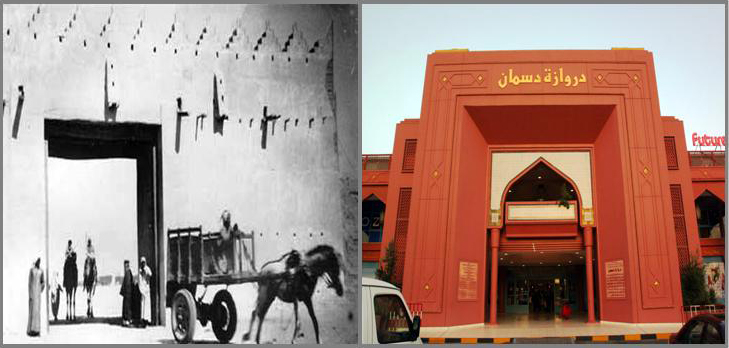Souk Al-Salmiah, one of the largest commercial centers in Kuwait, is considered to be a symbol of Kuwait’s urban renaissance. It was designed to house the modern amenities in an Islamic façade, making it an iconic complex of 3 main plazas designed with skylight domes named after the three Kuwaiti islands: Kubbar, Failaka, and Bubyan Skylights.
In the heart of its architecture, Souk Al-Salmiah was designed with six main gates or Derwazas serving as entrances to the market, in similitude to the gates of Kuwait’s Wall that protected the city.
In order to compliment the aesthetic of the project, 12,500 m 2 of landscape were dedicated for the garden. Souk Al-Salmiah is simply a destination encompassing both nature and an arabesque architecture, all in a harmonizing elegance that merges the old and the new.
Derwazas
In the 18 th century, Kuwait’s first wall was built around the city to protect it from invaders under the role of Sheikh Abdullah – the 1 st – Al-Sabah with five main Derwazas, which means gates in Persian language. Gates or Derwazas are also known to be an outstanding element of architecture that welcomed arrivals since the beginning of history. Thus, out of our firm belief that history is what shapes our present time, we were keen to reflect it in this commercial center’s design. The market has six main entrances starting off with the most historical Derwaza, Al-Shamiya, moving to Al-Jahra, Al-Maqsab, Al-Sha’b, Dasman, and finally Al-Tahrir. Souk Al-Salmiah Derwazas welcome today over 5 million visitors annually. (Read more)
Derwaza Al-Shamiya
Derwaza Al-Shamiya, known in the past times as Derwazat Naief due to its proximity to Naief Palace, is a historical gate that salvaged from any destruction throughout time. It welcomed whoever came from the north eastern Arabian Peninsula and is isolated today in a roundabout.
Derwaza Al-Jahra
Derwaza Al-Jahra was named after Al-Jahra village and was the only gate to witness urbanization until a road planning was developed. The gate linked northern coast to western side in the past and is isolated today in a roundabout.
Derwaza Al-Maqsab
Derwaza Al-Maqsab was named after the slaughterhouse located on the coast in the 1950s and was built to facilitate sailors and workers exit on their way to Shuwaikh. After it was destroyed during the infamous Iraqi invasion of Kuwait, the gate was rebuilt after liberation.
Derwaza Al-Sha’b
Derwaza Al-Sha’b, also known as Derwaza Al-Bar’isi, was named after the family name of its guard. This gate is the best exit for whoever wishes to go to the area of Sha’b, Dasma, Hawally or Al-Ras (Al-Salmiah).
Derwaza Dasman
Derwaza Dasman was named after Dasman Palace having been close to it. It is the first gate of the Wall on the east side, and although it did not salvage from the destruction of the infamous Iraqi invasion in 1990, the gate was later maintained after Kuwait liberation.
Derwaza Al-Tahrir
In commemoration of Kuwait’s liberation from the Iraqi invasion on the 26 th of February 1991, this gate came to be. It symbolizes the sheer glory of Kuwait’s freedom, and persistence to live and reconstruct all what’s been destroyed. This land shall, if Allah wills, never witness war again.









